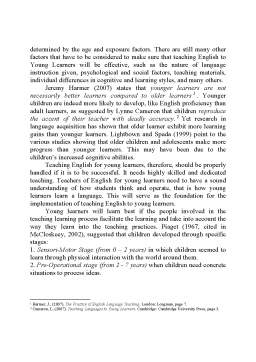Extras din curs
Primary school children go through a series of developmental stages and acquire social and independent skills progressively. When we teach children a foreign language we have to take into account their developmental stage and adapt tasks accordingly. Small children should not be asked to perform sophisticated tasks and, on the other hand, beginners of 11 or 12 should not be faced to activities that they may consider below their intellectual level. As a general rule, children treat language according to what they can do with it rather than an abstract system of rules. They show a high degree of motivation and tend to enjoy tasks because their learning is often unselfconscious.
Language learning and language acquisition
We have mainly two different ways to develop competence in a language: language acquisition and language learning.
Language acquisition is a subconscious process just like the way a child learns language. Language acquirers are not consciously aware of the grammatical rules of the language, but rather develop a feel for correctness. In non-technical language, acquisition is ‘picking-up’ a language.
Language learning, on the other hand, refers to the conscious knowledge of a second language, knowing the rules, being aware of them, and being able to talk about them. Thus language learning can be compared to learning about a language. Research shows that error correction has little effect on children learning a first language, so too much error correction has little affect on language acquisition.
Children acquire their mother tongue through interaction with their parents and the environment that surrounds them. Their need to communicate paves the way for language acquisition to take place. As experts suggest, there is an innate capacity in every human being to acquire language. By the time a child is five years old, he/she can express ideas clearly and almost perfectly from the point of view of language and grammar. Although, parents never sit with children to explain to them the workings of the language, their utterances show a superb command of intricate rules and patterns that would drive an adult crazy if s/he tried to memorize them and use them accurately. This suggests that it is through exposure to the language and meaningful communication that a first language is acquired, without the need of systematic studies of any kind.
When it comes to second language learning in children, one can notice that this happens almost identically to their first language acquisition. And even teachers focus more on the communicative aspect of the language rather than on just rules and patterns for the children to repeat and memorize. In order to acquire language, the learner needs a source of natural communication. The emphasis is on the text of the communication and not on the form. Young students who are in the process of acquiring a second language get plenty of “on the job” practice. They readily acquire the language to communicate with classmates. L1 is acquired and L2 is learned. This is because we understand that the first language is acquired through experience while the second language usually comes with formal teaching.
There are a few general points to bear in mind when it comes to teaching children a foreign language:
- keep the activities simple for the children to understand the instructions;
- maintain the tasks within their abilities and make them sufficiently stimulating to keep a high degree of motivation;
- use oral activities as much as possible;
- activities should be based on games and songs, TPR, coloring, simple, repetitive stories that have great communication value.
As children grow up they develop more intellectual, social and motor skills and a wider knowledge of the world. Tasks when acquiring a foreign language should have a gradual difficulty level and reflect a relevant, practical and communicative approach to language. When developing the children’s ‘learning to learn’ process, language should be considered as a vehicle of communication and not an abstract system of grammatical rules. If all four skills (listening, speaking, reading and writing) are gradually integrated in enjoyable activities, children will develop a positive attitude towards learning English and will have a sense of achievement which will develop motivation for further learning.
The order of language acquisition should be the following:
- present the language orally; the child listens
- then ask the children to reproduce the language orally; the child speaks
- then present language in the written form; the child reads
- finally ask them to reproduce this language in a written form; the child writes
Preview document
Conținut arhivă zip
- Teaching english to children - an overview.docx





















